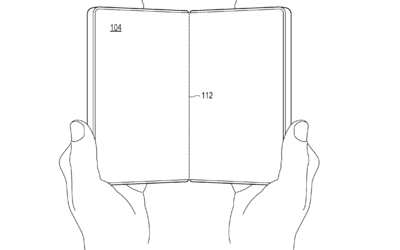Despite the discontinuation of its Surface Duo line, Microsoft is not abandoning its ambitions in the foldable device market. A newly unveiled patent application suggests the tech giant is exploring a fresh approach to foldable smartphone design, potentially challenging the dominance of iPhone and Android devices.

The patent, filed on February 29th with the United States Patent and Trademark Office, details a "spine cover plate" – a unique hinge mechanism designed to address key issues plaguing current foldable phones.
The patent application outlines a foldable smartphone concept featuring a single-hinge system. This design bears resemblance to the Samsung Galaxy Z Fold, adopting a book-style form factor with a flexible display. However, the core innovation lies in the spine cover plate.
This mechanism aims to protect the single-hinge system by encasing the structural elements. The differentiating factor is the spine cover's ability to automatically adjust during opening and closing, effectively sealing the hinge and preventing the ingress of dust and water. This could potentially lead to improved durability compared to existing foldable designs, some of which only offer limited water resistance (e.g., IPX8 rating).
Microsoft's patent also suggests that the new hinge mechanism could minimize the visibility of the crease, a common complaint among foldable phone users. Furthermore, the design incorporates techniques to reduce the overall thickness of the device when folded.
The patent states that by retracting the spine cover plate towards the central spine as the device folds, the width is reduced, leading to easier and more comfortable one-handed operation.
The industry is actively seeking solutions to eliminate the crease on foldable displays. While some manufacturers have implemented water-drop folding mechanisms to mitigate the issue, a truly crease-free foldable remains elusive. Durability is also a critical concern.
The addition of a movable spine cover plate raises questions about the overall practicality and reliability of the design. Despite the potential benefits outlined in the patent application, the complexity of the mechanism may introduce new vulnerabilities.
Older articles
 Ashada Gupt Navratri 2025: Unveiling Dates, Sacred Rituals & Hidden Significance of the Monsoon Festival
Ashada Gupt Navratri 2025: Unveiling Dates, Sacred Rituals & Hidden Significance of the Monsoon Festival
 Infrequent Bowel Movements: When Is It Time to Worry?
Infrequent Bowel Movements: When Is It Time to Worry?
 Royal Exit Strategy: Biographer Claims Financial Freedom, Brand Building Drove Harry and Meghan's Departure
OR
Harry and Meghan's Royal Exit: Biographer Uncovers Drive for Independence and Financial Gains
Royal Exit Strategy: Biographer Claims Financial Freedom, Brand Building Drove Harry and Meghan's Departure
OR
Harry and Meghan's Royal Exit: Biographer Uncovers Drive for Independence and Financial Gains
 New Zealand Cricket Announces Packed Home Schedule Against Australia, England, West Indies & South Africa
New Zealand Cricket Announces Packed Home Schedule Against Australia, England, West Indies & South Africa
 Beyond the Egg: 20 Vegetarian Foods Packed With More Protein
Beyond the Egg: 20 Vegetarian Foods Packed With More Protein
 Udaipur: India's "City of Lakes" Beckons with Palaces and Romance
Udaipur: India's "City of Lakes" Beckons with Palaces and Romance
 Toxic Workplace Alert: Spotting the Signs of a Negative Work Environment
Toxic Workplace Alert: Spotting the Signs of a Negative Work Environment
 Amazonian Scorpion Venom Yields Potential Breakthrough in Breast Cancer Treatment
Amazonian Scorpion Venom Yields Potential Breakthrough in Breast Cancer Treatment
 Nitish Rana Eyes Delhi Return After Disappointing Uttar Pradesh Stint
Nitish Rana Eyes Delhi Return After Disappointing Uttar Pradesh Stint
 Android Users Urged to Patch Now: Critical Security Flaws Expose Devices to Attacks
Android Users Urged to Patch Now: Critical Security Flaws Expose Devices to Attacks